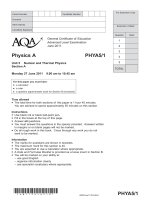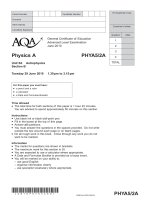AQA PHYA5 2b QP JUN13
Bạn đang xem bản rút gọn của tài liệu. Xem và tải ngay bản đầy đủ của tài liệu tại đây (470.68 KB, 12 trang )
Centre Number
For Examinerʼs Use
Candidate Number
Surname
Other Names
Examinerʼs Initials
Candidate Signature
Question
General Certificate of Education
Advanced Level Examination
June 2013
Mark
1
2
3
Physics A
PHYA5/2B
Unit 5B Medical Physics
Section B
Thursday 20 June 2013
4
TOTAL
9.00 am to 10.45 am
For this paper you must have:
l a calculator
l a ruler
l a Data and Formulae Booklet (enclosed).
Time allowed
l The total time for both sections of this paper is 1 hour 45 minutes.
You are advised to spend approximately 50 minutes on this section.
Instructions
l Use black ink or black ball-point pen.
l Fill in the boxes at the top of this page.
l Answer all questions.
l You must answer the questions in the spaces provided. Do not write
outside the box around each page or on blank pages.
l Do all rough work in this book. Cross through any work you do not
want to be marked.
l Show all your working.
Information
l The marks for questions are shown in brackets.
l The maximum mark for this section is 35.
l You are expected to use a calculator where appropriate.
l A Data and Formulae Booklet is provided as a loose insert.
l You will be marked on your ability to:
– use good English
– organise information clearly
– use specialist vocabulary where appropriate.
(JUN13PHYA52B01)
WMP/Jun13/PHYA5/2B
PHYA5/2B
Do not write
outside the
box
2
Section B
The maximum mark for this section is 35. You are advised to spend approximately
50 minutes on this section.
1
In the eye, rods and cones are used to detect light incident on the retina.
1 (a)
Describe how the rods and cones are distributed over the surface of the retina.
..............................................................................................................................................
..............................................................................................................................................
..............................................................................................................................................
..............................................................................................................................................
(2 marks)
1 (b)
On the axes below sketch three curves to show how the response of each of the three
types of cone found in the retina varies with the wavelength of light.
Label each of the three curves with the cone colour to which it refers.
relative
light
absorption
0
300
400
500
600
700
wavelength / nm
(3 marks)
(02)
WMP/Jun13/PHYA5/2B
Do not write
outside the
box
3
1 (c)
State the condition that must be satisfied for two objects to be resolved as individual
images on the retina.
..............................................................................................................................................
..............................................................................................................................................
(1 mark)
1 (d)
Explain how the resolution of the image of an object seen in very dim white light
compares to that of the image of the same object seen in bright white light.
..............................................................................................................................................
..............................................................................................................................................
..............................................................................................................................................
..............................................................................................................................................
..............................................................................................................................................
(2 marks)
8
Turn over for the next question
Turn over
(03)
ᮣ
WMP/Jun13/PHYA5/2B
Do not write
outside the
box
4
2 (a)
Sound waves are incident on the ear canal of a normal human ear. Describe the
physical processes involved in the transmission of the energy from the air through to the
inner ear.
Include an outline of how the variations in air pressure in the ear canal are amplified to
produce greater pressure variations in the inner ear.
The quality of your written communication will be assessed in your answer.
..............................................................................................................................................
..............................................................................................................................................
..............................................................................................................................................
..............................................................................................................................................
..............................................................................................................................................
..............................................................................................................................................
..............................................................................................................................................
..............................................................................................................................................
..............................................................................................................................................
..............................................................................................................................................
..............................................................................................................................................
..............................................................................................................................................
..............................................................................................................................................
..............................................................................................................................................
..............................................................................................................................................
..............................................................................................................................................
..............................................................................................................................................
..............................................................................................................................................
..............................................................................................................................................
(6 marks)
(04)
WMP/Jun13/PHYA5/2B
Do not write
outside the
box
5
2 (b)
Define intensity of sound.
..............................................................................................................................................
..............................................................................................................................................
..............................................................................................................................................
..............................................................................................................................................
(2 marks)
2 (c)
A human ear has a threshold of hearing of 54 dB at a given frequency. Calculate the
intensity of sound incident on the ear at this frequency.
Give your answer to an appropriate number of significant figures.
Io = 1.0 × 10–12 W m–2
intensity of sound ................................... W m–2
(3 marks)
11
Turn over for the next question
Turn over
(05)
ᮣ
WMP/Jun13/PHYA5/2B
Do not write
outside the
box
6
3 (a)
Figure 1 shows an ultrasound transducer used in an A-scan.
Figure 1
metal case
backing material
electrodes
piezoelectric
crystal
co-axial cable
acoustic insulator
plastic membrane
Outline, with reference to the diagram, the process by which the transducer produces a
short pulse of ultrasound.
..............................................................................................................................................
..............................................................................................................................................
..............................................................................................................................................
..............................................................................................................................................
..............................................................................................................................................
..............................................................................................................................................
..............................................................................................................................................
..............................................................................................................................................
..............................................................................................................................................
..............................................................................................................................................
..............................................................................................................................................
(4 marks)
(06)
WMP/Jun13/PHYA5/2B
Do not write
outside the
box
7
3 (b)
Ultrasound is incident on the boundary between two materials. Some of the ultrasound
is reflected at the boundary and the remainder is transmitted across the boundary. The
ratio of the intensity of the reflected ultrasound, Ir, to the intensity of the incident
ultrasound, Ii , is given by the equation
(
)
Z2 – Z1
I
––r = –––––––
Z 2 + Z1
Ii
2
where Z1 and Z2 are the acoustic impedances of the two materials.
3 (b) (i) Calculate the percentage of the incident ultrasound which would be transmitted into the
skin when incident on an air-skin boundary.
acoustic impedance of air = 4.29 × 102 kg m–2 s–1
acoustic impedance of skin = 1.65 × 106 kg m–2 s–1
transmitted percentage .......................................... %
(2 marks)
3 (b) (ii) When obtaining the ultrasound image of an unborn foetus, a coupling gel is used.
Explain why a coupling gel is needed and state the property of the gel that ensures a
good quality image.
..............................................................................................................................................
..............................................................................................................................................
..............................................................................................................................................
..............................................................................................................................................
..............................................................................................................................................
..............................................................................................................................................
(2 marks)
8
Turn over
(07)
ᮣ
WMP/Jun13/PHYA5/2B
Do not write
outside the
box
8
4
Figure 2 shows how the membrane potential of a nerve cell varies with time.
Figure 2
membrane
potential
C
B
D
A
time
4 (a)
Complete Figure 2 by adding units and values to both axes.
(3 marks)
4 (b) (i) State the value of the resting potential.
..............................................................................................................................................
(1 mark)
4 (b) (ii) Name the process involved between points A and B on the curve and describe the ion
movement which produces this change.
process .................................................................................................................................
ion movement .......................................................................................................................
..............................................................................................................................................
(2 marks)
(08)
WMP/Jun13/PHYA5/2B
Do not write
outside the
box
9
4 (b) (iii) Name the process involved between points C and D on the curve and describe the ion
movement which produces this change.
process ..................................................................................................................................
ion movement .......................................................................................................................
..............................................................................................................................................
(2 marks)
8
END OF QUESTIONS
(09)
WMP/Jun13/PHYA5/2B
10
There are no questions printed on this page
DO NOT WRITE ON THIS PAGE
ANSWER IN THE SPACES PROVIDED
(10)
WMP/Jun13/PHYA5/2B
11
There are no questions printed on this page
DO NOT WRITE ON THIS PAGE
ANSWER IN THE SPACES PROVIDED
(11)
WMP/Jun13/PHYA5/2B
12
There are no questions printed on this page
DO NOT WRITE ON THIS PAGE
ANSWER IN THE SPACES PROVIDED
Copyright © 2013 AQA and its licensors. All rights reserved.
(12)
WMP/Jun13/PHYA5/2B









